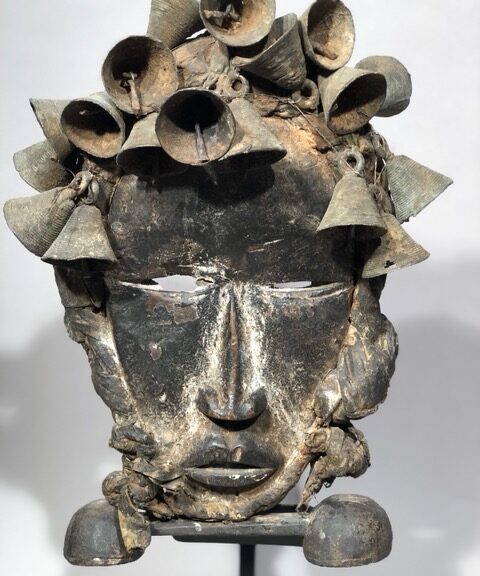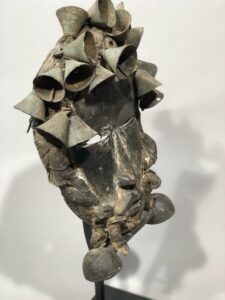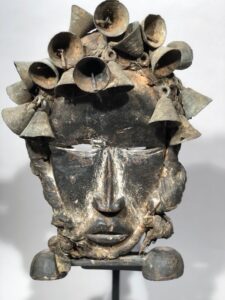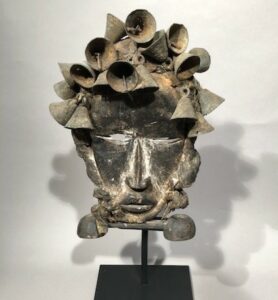LSK 1121-3
Kuba Bwoom Helmet Mask, D.R. Congo
One of the three royal Kuba helmet masks, the “Bwoom” mask is the oldest of the mask types used by the Kuba of the Democratic Republic of the Congo. It is said that this type of mask was introduced in the seventeenth century. The masquerades appear on numerous ceremonial occasions and embody different characters depending on the context. At boys’ initiations, Bwoom represents the nature spirit Ngeesh. As part of the Royal Mask Trio, he personifies an oppositional, recalcitrant character who fights with his brother Woot for power and for the possession of his wife and sister, Ngaady a Mwaash. Furthermore, in his role as a rebel challenging the throne and its system, Bwoom is associated with non-aristocratic, common man. The rebellious aspect of the Bwoom masquerade is expressed in a proud and aggressive dance style. According to one of the various legends surrounding the Bwoomen’s origins, the bulging forehead and shape of the mask mimics the head of pygmies.
This beautiful large ‘bwoom mask’ is created in a mixture of ‘knotted weave’, like a ‘lattice’ and partly coated with clay and in traditional style shaped and painted with punched patterns, and colored red and brown. Its high, broad forehead, both cheeks and mouth are covered in color. . The larger decorative surfaces, on the head at the top, at the back, at the side flaps and at the edge below, are covered with raffia fabric.
A special feature of the Kuba bwoom masks are the large circular ‘eyes’ and the open mouth. A perfect example of a ‘bwoom’ mask by Kuba.
In excellent condition, with only minimal damage (small paint scratches in places). And yet with an excellent, old, partially shiny patina of use on the outside and especially on the inside of the ‘helmet’.
Age: Est. beg. 21st. century.
Measure: H: 59, W: 26, D: 27 cm.
Provenience: From Italian collection and acquired by Danish heirs.
Literature about Royal Kuba helmet masks:
One of the three royal masks, the Bwoom is one of the oldest mask types used by the Kuba, who live in the Democratic Republic of the Congo. It is said to have been introduced in the seventeenth century. The masquerades appear on numerous ceremonial occasions, embodying different characters depending on the context. At boys’ initiations, Bwoom represents the nature spirit Ngeesh. As part of the royal mask trio, he personifies an oppositional, recalcitrant character who fights with his brother Woot for power and for the possession of his wife and sister, Ngaady a Mwaash. Furthermore, in his role as a rebel who challenges the throne and its system, Bwoom is associated with non-aristocratic, common man. The rebellious aspect of the Bwoom masquerade is expressed in a proud and aggressive dance style. According to one of the various legends surrounding the origin of Bwoom, the bulging forehead and shape of the mask mimic the heads of pygmies.
Request price for Kuba, D.R. Congo




